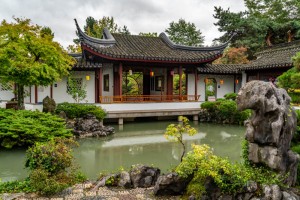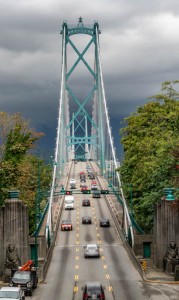Sorry for the delay in posting. The internet in Vancouver and Victoria was less than desired. I am home now, and apparently ran myself down, and froze on the flight home – so now I am fighting with my sinuses.
This was the last day of the full group. We started out with a drive to Chinatown.
We stopped to visit Dr Sun Yat-Sen Classical Chinese Garden. Chan made sure we got our steps in as we walked around the entrance a couple of times. Here Chan is laughing over getting us to the entrance.
The Dr. Sun Yat Sen Classical Chinese Garden is the first Chinese or “scholars” gardenbuilt outside of China, and is located in Chinatown in Vancouver, British Columbia, Canada. It consists of a freely accessible public park and a garden with an admission fee. The mandate of the garden is to “maintain and enhance the bridge of understanding between Chinese and western cultures, promote Chinese culture generally and be an integral part of the local community.”
The garden was built in 1985–1986. The outer park was designed by architects Joe Wai and Donald Vaughan, while the inner garden was conceived by Wang Zu-Xin as the chief architect, with the help of experts from the Landscape Architecture Company of Suzhou, China. It opened on April 24, 1986, in time for Expo 86.
Because the winter climate in Vancouver is similar to that of Suzhou, many of the same plant varieties are found in the garden as in its Suzhou counterparts. The plants were chosen according to their blossom schedules in order to emphasize seasonal changes, especially the “awakening” in spring. They are also selected to invoke the symbolic, historical, and literary meaning of each plant and are used sparingly, in contrast to western gardens, and provide color through all the seasons.
Classical Chinese gardens employ philosophical principles of Feng shui and Taoism, striving to achieve harmony and a balance of opposites. Craggy rocks, for example, are juxtaposed against delicate foliage. Water is also an important element of the garden, and the large pond offers stillness, sound, a reflection of the sky, and helps to unify the other elements. Fish and turtles live in the garden and also serve a symbolic purpose. Bats, dragons, and phoenixes are represented in objects throughout the garden. Numerous large rocks are strategically placed and are intended to represent mountains concealing and revealing park elements.
The garden is named in honor of Dr. Sun Yat Sen, a nationalist leader who is considered the “father of modern China.” The attribution is not arbitrary, as it emphasizes his connection with Vancouver. While traveling the world to raise awareness of, and funding for, the Chinese nationalist movement, Sun Yat-Sen stayed in Vancouver on three different occasions for extended periods. At the time, there was a significant presence of Chinese nationalists in British Columbia, who helped finance the Xinhai Revolution that overthrew the Qing Dynasty in 1911. Sun Yat Sen subsequently became the first president of the Republic of China.
Our interpreter explained the yin yang of objects in each of the areas in the gardens, the significance of certain patterns in the walls, and stone floors. The Yin, or the dark side, is associated with everything hard, negative, cold, wet, and feminine. The Yang, or the light side, is associated with things soft, positive, warm, dry, and masculine. But contrary to the harsh juxtaposition of their appearances, Yin and Yang are not complete opposites.





 This tapestry panel can be viewed from both sides.
This tapestry panel can be viewed from both sides. The detail in the carving of this tabletop.
The detail in the carving of this tabletop.









 the interesting pattern in the stone work in the yards in the central area
the interesting pattern in the stone work in the yards in the central area 
 A couple of the window patterns. We then sat and had some Jasmine Tea and looked at some of the artwork –
A couple of the window patterns. We then sat and had some Jasmine Tea and looked at some of the artwork –  This is hard to see but it is a Chinese character done in charcoal, it is on a mirrored surface, the bars are the ceiling beams. The orange square is the artist’s signature, which would have been a stamp on paper or fabric.
This is hard to see but it is a Chinese character done in charcoal, it is on a mirrored surface, the bars are the ceiling beams. The orange square is the artist’s signature, which would have been a stamp on paper or fabric.
We then headed over to Granville Island Public Market for us to walk around, have lunch, shop or just relax.  painted silos and interesting buildings.
painted silos and interesting buildings.

 Chan without an ice cream (yet) and Andy.
Chan without an ice cream (yet) and Andy. 



 even a pet store.
even a pet store.
And what would a public market be without goodies – 
 We were then off to take a False Creek ferry across.
We were then off to take a False Creek ferry across. 

 and mussels that were uncovered by the tide – grow up lil guys.
and mussels that were uncovered by the tide – grow up lil guys. 
We then headed to Stanley Park which we missed the day before due to rain. We were able to see the totem park. 













We had some great views from this park. – One of the oil tankers sitting waiting – 
And the skyline – ![]() And the statue – which was to be like the Mermaid Sculpture in Copenhagen – but the artist did it as a wetsuit instead of a mermaid to avoid copyright infringement.
And the statue – which was to be like the Mermaid Sculpture in Copenhagen – but the artist did it as a wetsuit instead of a mermaid to avoid copyright infringement. Girl in a Wetsuit is a life size 1972 bronze sculpture by Elek Imredy of a woman in a wetsuit, located on a rock in the water along the north side of Stanley Park.
Girl in a Wetsuit is a life size 1972 bronze sculpture by Elek Imredy of a woman in a wetsuit, located on a rock in the water along the north side of Stanley Park.
We then drove to Prospect Point. This is a point at the northern tip of Stanley Park in Vancouver, located on the south side of the First Narrows of Burrard Inlet. The point, which as its name suggests, is a viewpoint, landmark and tourist attraction in Stanley Park and has a restaurant and other facilities, is just west of the Lions Gate Bridge. 


And Andy being good-natured to pose for us in the crack in the tree.
We headed back to our hotel for our farewell dinner to some of the group.

